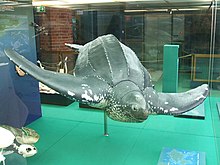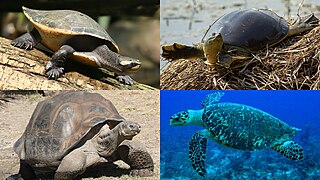
Turtles are of reptiles of the order Testudines, characterized by a special shell developed mainly from their ribs. Modern turtles are divided into two major groups, the Pleurodira and Cryptodira, which differ in the way the head retracts. There are 360 living and recently extinct species of turtles, including land-dwelling tortoises and freshwater terrapins. They are found on most continents, some islands, and, in the case of sea turtles, much of the ocean. Like other amniotes they breathe air and do not lay eggs underwater, although many species live in or around water.

Sea turtles, sometimes called marine turtles, are reptiles of the order Testudines and of the suborder Cryptodira. The seven existing species of sea turtles are the flatback, green, hawksbill, leatherback, loggerhead, Kemp's ridley, and olive ridley sea turtles. All of the seven species listed above, except for the flatback, are present in US waters, and are listed as endangered and/or threatened under the Endangered Species Act. The flatback itself exists in the waters of Australia, Papua New Guinea and Indonesia. Sea turtles can be categorized as hard-shelled (cheloniid) or leathery-shelled (dermochelyid). The only dermochelyid species of sea turtle is the leatherback.

Cheloniidae is a family of typically large marine turtles that are characterised by their common traits such as, having a flat streamlined wide and rounded shell and almost paddle-like flippers for their forelimbs. They are the only sea turtles to have stronger front limbs than back limbs. The six species that make up this family are: the green sea turtle, loggerhead sea turtle, olive ridley sea turtle, hawksbill sea turtle, flatback sea turtle and the Kemp's ridley sea turtle.

The leatherback sea turtle, sometimes called the lute turtle, leathery turtle or simply the luth, is the largest of all living turtles and the heaviest non-crocodilian reptile, reaching lengths of up to 1.8 metres and weights of 500 kilograms (1,100 lb). It is the only living species in the genus Dermochelys and family Dermochelyidae. It can easily be differentiated from other modern sea turtles by its lack of a bony shell; instead, its carapace is covered by oily flesh and flexible, leather-like skin, for which it is named.

The Dermatemydidae are a family of turtles. The family was named by John Edward Gray in 1870, and its only extant genus is Dermatemys.

Blanding's turtle is a semi-aquatic turtle of the family Emydidae. This species is native to central and eastern parts of Canada and the United States. It is considered to be an endangered species throughout much of its range. Blanding's turtle is of interest in longevity research, as it shows few or no common signs of aging and is physically active and capable of reproduction into eight or nine decades of life.
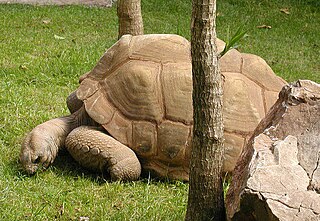
The Cryptodira are a suborder of Testudines that includes most living tortoises and turtles. Cryptodira differ from Pleurodira in that they lower their necks and pull the heads straight back into the shells, instead of folding their necks sideways along the body under the shells' marginals. They include among their species freshwater turtles, snapping turtles, tortoises, softshell turtles, and sea turtles.

Kinosternoidea is a superfamily of aquatic turtles, which includes two families: Dermatemydidae, and Kinosternidae.

Trionychia is a superfamily of turtles which encompasses the species that are commonly referred to as softshelled turtles as well as some others. The group contains two families, Carettochelyidae, which has only one living species, the pig-nosed turtle native to New Guinea and Northern Australia, and Trionychidae, the softshelled turtles, containing numerous species native to Asia, North America and Africa. These families likely diverged during the late Jurassic. The oldest known stem-trionychian is Sinaspideretes from the Late Jurassic of China.

Protostega is an extinct genus of sea turtle containing a single species, Protostega gigas. Its fossil remains have been found in the Smoky Hill Chalk formation of western Kansas, time-equivalent beds of the Mooreville Chalk Formation of Alabama and Campanian beds of the Rybushka Formation. Fossil specimens of this species were first collected in 1871, and named by Edward Drinker Cope in 1872. With a total length of 3.9 metres (13 ft), it is the second-largest sea turtle that ever lived, second only to the giant Archelon, and one of the three largest turtle of all time along Archelon and Gigantatypus.

Testudinoidea is a superfamily within the suborder Cryptodira of the order Testudines. It includes the pond turtles, Asian turtles, the monotypic big-headed turtle, and the tortoises.
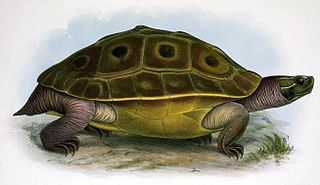
The Burmese eyed turtle, also known as the Bengal eyed terrapin, Burmese peacock turtle or swamp turtle, is a species of turtle in the family Geoemydidae of southern Asia.

Protostegidae is a family of extinct marine turtles that lived during the Cretaceous period. The family includes some of the largest sea turtles that ever existed. The largest, Archelon, had a head one metre (39 in) long. Like most sea turtles, they had flattened bodies and flippers for front appendages; protostegids had minimal shells like leatherback turtles of modern times.
Corsochelys is an extinct genus of sea turtle that lived in the Late Cretaceous (Campanian). Zangerl (1960) named the type species, based upon remains found in Alabama within the Mooreville Chalk Formation.
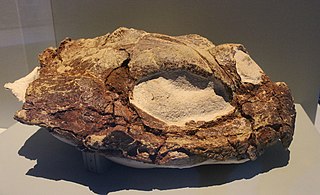
Psephophorus is an extinct genus of sea turtle that lived from the Oligocene to the Pliocene. Its remains have been found in Europe, Africa, North America, and New Zealand. It was first named by Hermann von Meyer in 1847, and contains seven species, P. polygonus, P. calvertensis, P. eocaenus, P. oregonesis, P. californiensis, P. rupeliensis, P. scaldii, and a species discovered in 1995, P. terrypratchetti.

Mesodermochelys is an extinct genus of sea turtle known from the Campanian to the Maastrichtian of what today is Japan. One species is known, the type species M. undulatus; it was given its binomial name by Ren Hirayama and Tsutomu Chitoku in 1996. Studies of its skull indicate that it was a primitive member of the Dermochelyidae that was closely related to the Protostegidae. It has been described as the best representative of Mesozoic dermochelyids.

Batagur is a genus of large turtles from South and Southeast Asia. All members of the genus are seriously threatened. With a recent merger with members from two other genera, this genus has six described species.
The Ivory Coast mud turtle is a species of turtle in the family Pelomedusidae. It is one of the most recently described turtle species.
The Pelusios cupulatta is typically found in riverine and wetland habitats mainly located in the southern Ivory Coast of West Africa. Endemic to the Upper Guinean forest region such as wetlands/rivers they are usually found primarily in forested banks as well as aquatic vegetation. Compared to other counterparts within its family, P. Cupulatta prefers an abundance of aquatic vegetation as its primary habitat. Despite this, Pelusios castaneus is a potential competitor due to similar habitats albeit different preferences regarding specific locations. Interspecific competition is able to regulate the coexistence of potential competitors but also niche expansion is available within the family when alone.
Comparative to other species at a local spatial level, Pelusios niger and Pelusios cupulatta both belong to larger size categories compared to others within the Pelusios records with the maximum male SCL being 31.3 and the maximum female SCL being 27.1. The two different turtle species are also allopatric, meaning that they are related but occur in separate non-overlapping geographical areas compared to the sympatric of P. castaneus. White P. castaneus intensely uses forested banks, P, and cupulatta aren't typically found in such areas as they aim for places with large amounts of aquatic vegetation. In presence of P. niger, P. cupulatta are usually found less than 10 km away showing how closely these two groups typically reside at roughly close locations.
The African dwarf mud turtle is a species of turtle in the family Pelomedusidae. It is endemic to Africa : in Angola, the Democratic Republic of the Congo, Malawi, and Zambia. These mud turtles are the smallest of all African turtle species, “Nanus” which they are referred to are one of the 3 smallest turtle species in the world. The other two are Stink Pot Musk and Muhlenberg's Bog Turtles. All 3 species barely reach 4 inches as full grown adults. Like many of the world's chelonians, Pelusios castaneus has the potential to live a long life. Reports typically suggest more than 50 years in captivity for this species.

Pancheloniidae is a clade of sea turtles It is defined as all turtles more closely related to cheloniid sea turtles than to dermochelyid ("leatherback") sea turtles.
